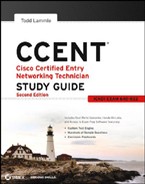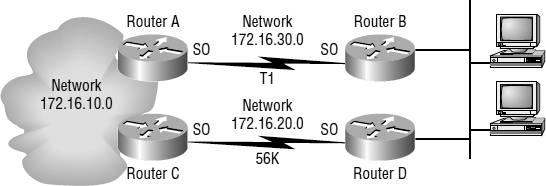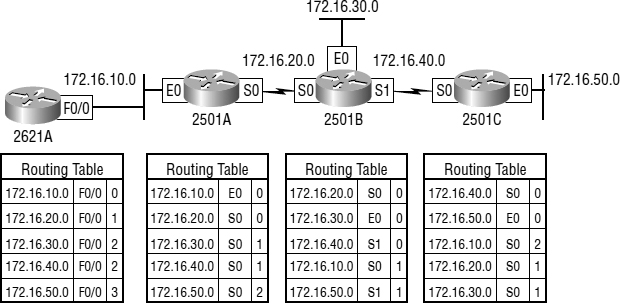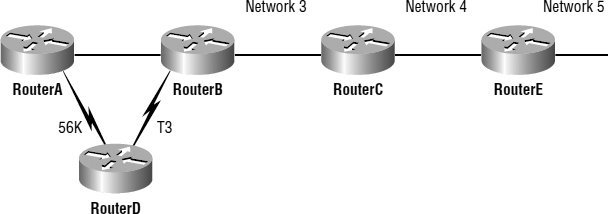Distance-Vector Routing Protocols
The distance-vector routing algorithm passes complete routing table contents to neighboring routers, which then combine the received routing table entries with their own routing tables to complete the router's routing table. This is called routing by rumor because a router receiving an update from a neighbor router believes the information about remote networks without actually finding out for itself.
It's possible to have a network that has multiple links to the same remote network, and if that's the case and if the routes were learned from different routing protocols, the administrative distance of each received update is checked first. If the AD is the same (which typically means the routes came from the same routing protocol), the protocol will have to use metrics to determine the best path to use to that remote network.
RIP uses only hop count to determine the best path to a network. If RIP finds more than one route with the same hop count to the same remote network, it will automatically perform round-robin load balancing. RIP can perform load balancing for up to sixteen equal-cost links (four by default).
However, a problem with this type of routing metric arises when the two routes to a remote network have different bandwidths but the same hop count. Figure 6.13, for example, shows two links to remote network 172.16.10.0.
FIGURE 6.13 Pinhole congestion
Since network 172.16.30.0 is a T1 link with a bandwidth of 1.544Mbps and network 172.16.20.0 is a 56K link, you'd want the router to choose the T1 over the 56K link, right? But because hop count is the only metric used with RIP routing, the two links would be seen as being of equal cost. This little snag is called pinhole congestion.
It's important to understand what a distance-vector routing protocol does when it starts up. In Figure 6.14, the four routers start off with only their directly connected networks in their routing tables. After a distance-vector routing protocol is started on each router, the routing tables are updated with all route information gathered from neighbor routers.
FIGURE 6.14 The internetwork with distance-vector routing
As shown in Figure 6.14, each router has only the directly connected networks in each routing table. Each router sends its complete routing table out to each active interface. The routing table of each router includes the network number, exit interface, and hop count to the network.
In Figure 6.15, the routing tables are complete because they include information about all the networks in the internetwork. They are considered converged. When the routers are converging, it is possible that no data will be passed. That's why fast convergence time is a serious plus. In fact, that's one of the problems with RIP—its slow convergence time.
FIGURE 6.15 Converged routing tables
The routing table in each router keeps information regarding the remote network number, the interface to which the router will send packets to reach that network, and the hop count or metric to the network.
Routing Loops
Distance-vector routing protocols keep track of any changes to the internetwork by broadcasting periodic routing updates out all active interfaces. This broadcast includes the complete routing table. This works just fine, but it's expensive in terms of CPU processing and link bandwidth. And if a network outage happens, real problems can occur. Plus, the slow convergence of distance-vector routing protocols can result in inconsistent routing tables and routing loops.
Routing loops can occur because every router isn't updated simultaneously, or even close to it. Here's an example—let's say that the interface to Network 5 in Figure 6.16 fails. All routers know about Network 5 from RouterE. RouterA, in its tables, has a path to Network 5 through RouterB.
FIGURE 6.16 Routing loop example
When Network 5 fails, RouterE tells RouterC. This causes RouterC to stop routing to Network 5 through RouterE. But routers A, B, and D don't know about Network 5 yet, so they keep sending out update information. RouterC will eventually send out its update and cause B to stop routing to Network 5, but routers A and D are still not updated. To them, it appears that Network 5 is still available through RouterB with a metric of 3.
The problem occurs when RouterA sends out its regular 30-second “Hello, I'm still here—these are the links I know about” message, which includes the ability to reach Network 5, and now routers B and D receive the wonderful news that Network 5 can be reached from RouterA, so routers B and D then send out the information that Network 5 is available. Any packet destined for Network 5 will go to RouterA, to RouterB, and then back to RouterA. This is a routing loop—how do you stop it?
Maximum Hop Count
The routing loop problem just described can create an issue called counting to infinity, and it's caused by gossip (broadcasts) and wrong information being communicated and propagated throughout the internetwork. Without some form of intervention, the hop count increases indefinitely each time a packet passes through a router.
One way of solving this problem is to define a maximum hop count. RIP permits a hop count of up to 15, so anything that requires 16 hops is deemed unreachable. In other words, after a loop of 15 hops, Network 5 will be considered down. Thus, the maximum hop count will control how long it takes for a routing table entry to become invalid or questionable.
Split Horizon
Another solution to the routing loop problem is called split horizon. This reduces incorrect routing information and routing overhead in a distance-vector network by enforcing the rule that routing information cannot be sent back in the direction from which it was received.
In other words, the routing protocol differentiates which interface a network route was learned on, and once this is determined, it won't advertise the route back out that same interface. This would have prevented RouterA from sending the update information it received from RouterB back to RouterB.
Route Poisoning
Another way to avoid problems caused by inconsistent updates and stop network loops is route poisoning. For example, when Network 5 goes down, RouterE initiates route poisoning by advertising Network 5 with a hop count of 16, or unreachable (sometimes referred to as infinite).
This poisoning of the route to Network 5 keeps RouterC from being susceptible to incorrect updates about the route to Network 5. When RouterC receives a route poisoning from RouterE, it sends an update, called a poison reverse, back to RouterE. This ensures that all routers on the segment have received the poisoned route information.
Holddowns
A holddown prevents regular update messages from reinstating a route that is going up and down (called flapping). Typically, this happens on a serial link that's losing connectivity and then coming back up. If there wasn't a way to stabilize this, the network would never converge, and that one flapping interface could bring the entire network down!
Holddowns prevent routes from changing too rapidly by allowing time for either the downed route to come back up or the network to stabilize somewhat before changing to the next best route. These also tell routers to restrict, for a specific time period, changes that might affect recently removed routes. This prevents inoperative routes from being prematurely restored to other routers' tables.




